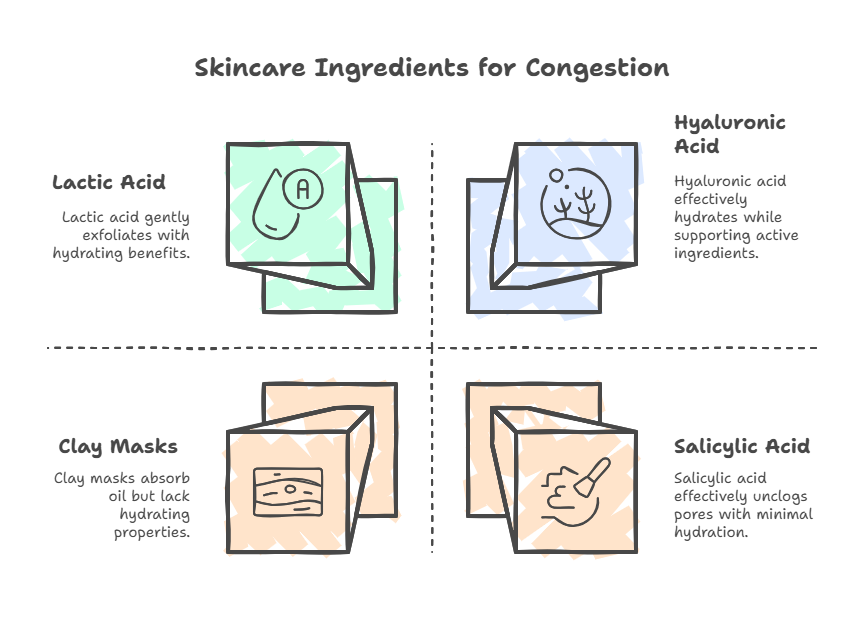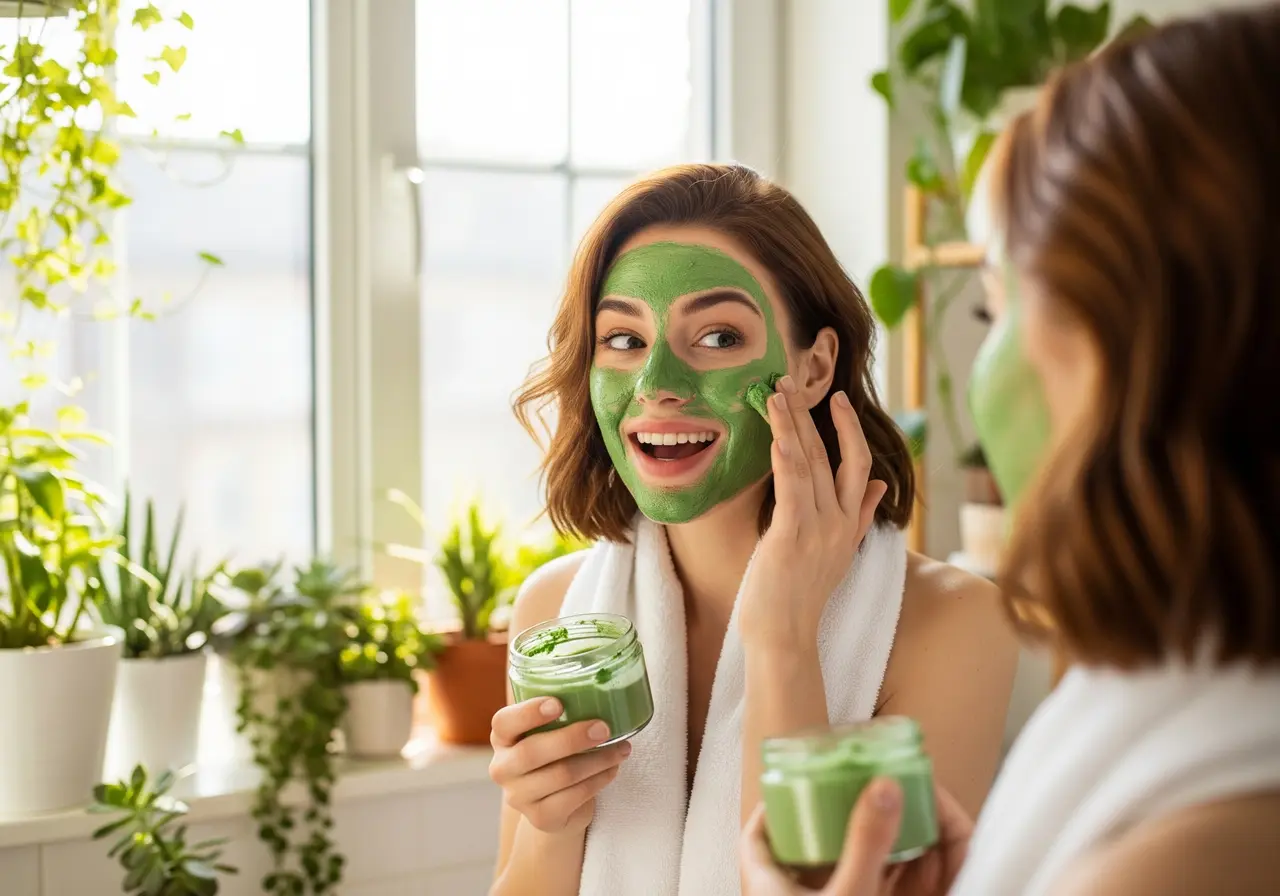Feeling like your skin just isn’t cooperating? You look in the mirror and see bumpy texture, little black dots, or maybe just clogged pores that won’t go away. Skin congestion is frustrating, and figuring out the best products for skin congestion can feel overwhelming with so many options out there.
“Clogged pores are often the result of excess oil, dead skin cells, and bacteria. Incorporating exfoliating acids like glycolic acid can significantly improve skin texture and clarity over time.”
Dr. Whitney Bowe
It seems like everyone has a different opinion or magic cure for this common skin concern. Finding what truly works for your skin takes time and understanding what causes those pesky bumps and uneven skin texture. You’ll learn about some effective approaches and discover some of the best products for skin congestion available today, helping you achieve smoother skin.
Understanding Skin Congestion: What Is It Exactly?
So, what exactly is skin congestion? Think of it as a traffic jam within your pores. Normally, your skin naturally sheds dead skin cells, and oils produced by sebaceous glands (sebum) flow freely out.
But sometimes, this natural process gets disrupted, leading to congestion skin. Congestion happens when pores get clogged with a mixture of dead cells, excess oil, dirt, and sometimes makeup or skincare product residue. This blockage can lead to several visible skin concerns.
You might notice blackheads, which are open clogged pores where the trapped mixture oxidizes and turns dark. Whiteheads are closed clogged pores, appearing as small white bumps. Often, there’s just a general rough, uneven skin texture making the skin feel bumpy.
Many factors contribute to this pore blockage, a common skin condition. Producing too much oil (excess oil) is a frequent cause, especially for those with oily skin or combination skin types. Dead skin cells not shedding efficiently can also build up, trapping sebum inside the pore.
Environmental stressors like pollution particles and comedogenic (pore-clogging) ingredients found in some skincare products or makeup definitely play a role, as explained by experts at the American Academy of Dermatology Association. Hormonal fluctuations, such as those during menstrual cycles or periods of stress, can increase oil production from oil glands. For some individuals, dietary factors might also influence sebum production and inflammation, contributing to blocked pores.
While congestion isn’t always the same as inflammatory acne (which involves red, swollen pimples), it frequently co-exists or can worsen if not managed. Addressing clogged pores early is helpful for preventing clogged pores from becoming more inflamed breakouts. Understanding your specific triggers and skin type is crucial.
Key Ingredients to Look For
When searching for skincare products to help clear congestion, specific ingredients are known for their effectiveness. Understanding how they work helps you choose the right face wash, serum, or treatment. These ingredients target the main causes of congested pores: excess oil and the buildup of dead skin cells.

Salicylic Acid (BHA)
Salicylic acid is a beta-hydroxy acid (BHA), celebrated for its ability to combat skin congestion. Its chemical structure makes it oil-soluble. This characteristic allows it to penetrate deeper into pores that are lined with sebum, unlike water-soluble acids.
Once inside the pore, salicylic acid works to dissolve the mixture of excess oil and dead skin cells that form the clog, helping to unclog pores. It also possesses mild anti-inflammatory properties, which can soothe some associated redness. This makes salicylic acid an excellent choice for addressing blackheads, whiteheads, and generally clogged pores, especially beneficial if you have oily skin.
You can find salicylic acid in various skincare products, including facial cleansers, toners, spot treatments, and leave-on exfoliants. Consistency is important for seeing results, but start slowly to assess tolerance.
Glycolic Acid & Lactic Acid (AHAs)
Glycolic acid belongs to the alpha-hydroxy acid (AHA) family. Unlike BHAs, AHAs are water-soluble and primarily work on the skin’s surface. Glycolic acid is particularly effective at loosening the bonds between dead skin cells on the outermost layer of the skin.
This action promotes exfoliation, helping to shed dull, dead cells and reveal smoother, brighter skin underneath. By keeping the surface clear, it improves skin texture and can indirectly help in preventing clogged pores in the future. It’s often favored for addressing roughness and a dull appearance linked to congestion.
Lactic acid is another common AHA, known for being slightly gentler than glycolic acid due to its larger molecule size. It also exfoliates the surface but provides hydrating benefits as well, making it a good option for those with dry skin or sensitive skin experiencing congestion. Both glycolic acid and lactic acid can improve skin tone over time1.
Niacinamide
Niacinamide, a form of vitamin B3, is a versatile ingredient offering multiple benefits for skin health. It’s particularly noted for helping to regulate oil production from the sebaceous glands. By controlling excess oil, there’s less sebum available to contribute to clogged pores.
Research also indicates that niacinamide can help minimize the appearance of large pores or enlarged pores and possesses anti-inflammatory properties. This helps calm redness that might accompany skin congestion or breakouts. It’s generally well-tolerated by various skin types, including sensitive skin, and pairs effectively with other active ingredients in a skincare routine2.
You’ll commonly find niacinamide in serums and moisturizers, often combined with ingredients like hyaluronic acid to boost hydration.
Retinoids
Retinoids are powerful derivatives of vitamin A, renowned for their impact on skin cell turnover. They work by accelerating the rate at which skin cells shed and are replaced. This rapid turnover helps prevent dead skin cells from accumulating and causing blocked pores.
Retinoids are renowned for their ability to regulate oil production and reduce inflammation, making them effective against congestion and acne. Over-the-counter options include retinol and adapalene, while stronger forms like tretinoin require a prescription from a doctor or board-certified dermatologist. As highlighted by dermatology resources, retinoids must be introduced carefully into a skincare routine.
Among these, retinaldehyde stands out as a potent yet gentle option. It requires only one conversion step to become active retinoic acid, making it more efficient than retinol, which needs two. This efficiency allows for faster results in improving skin texture and reducing signs of aging. Additionally, retinaldehyde has been shown to boost collagen production, enhance skin elasticity, and improve overall skin tone. Its antimicrobial properties also make it effective in combating acne-causing bacteria. For a comprehensive understanding of retinaldehyde and its benefits, you can refer to the detailed guide on StayHealthee: Retinaldehyde: Transform Aging Skin Overnight.
Start with a low concentration just a few nights per week, gradually increasing frequency as tolerated. Diligent use of sun protection (SPF 30 or higher) daily is essential, as retinoids increase the skin’s sensitivity to UV radiation. Initial dryness, peeling, or irritation are common but often manageable with proper introduction and hydration.
Clay (Kaolin/Bentonite)
Clay, especially kaolin and bentonite varieties, is a staple ingredient in many face masks designed for oily and congested skin. These clays possess porous structures that are excellent at absorbing excess oil from the skin’s surface. This action helps to temporarily reduce shine and can draw out some impurities lodged within pores.
Using a clay mask perhaps once or twice a week can be a beneficial supplement to a skincare routine focused on managing congestion. They offer a deep-cleansing feeling and can help restore balance to oily areas. However, it’s important not to overuse them, as excessive use can strip the skin of necessary moisture, potentially leading to irritation or even rebound oiliness if the skin becomes dehydrated skin.
Hyaluronic Acid
While not directly exfoliating or unclogging pores, hyaluronic acid plays a crucial supportive role, especially when using active ingredients like acids and retinoids. It’s a powerful humectant, meaning it draws moisture from the environment into the skin. Maintaining good hydration and healthy moisture levels is vital for overall skin health.
Dehydrated skin can sometimes compensate by producing more oil, worsening congestion. Furthermore, active ingredients can sometimes cause dryness or irritation. Using products with hyaluronic acid can help counteract this, keeping the skin plump, hydrated, and supporting the skin barrier, which improves the overall skin feel3.
The Best Products for Skin Congestion: Our Top Picks
Finding effective products for skin congestion among the vast array of skincare products available can be tricky. Based on proven ingredients and positive user experiences, here are some types of products and examples that are worth exploring. Remember that individual skin types and conditions vary, so what works well for one person might not suit another; patch testing is always recommended4.
Cleansers for Congested Skin
Your cleanser, or face wash, is the foundational step in your skincare routine. The goal is to find facial cleansers that clean the skin thoroughly, removing dirt, oil, and makeup, without stripping the natural moisture barrier. A compromised barrier can sometimes lead to increased oiliness and worsen skin congestion5.
One frequently recommended option is the CeraVe SA Cleanser. It contains salicylic acid for gentle exfoliation that helps clear pores. It also features ceramides, which support the skin barrier, making it less likely to feel harsh or drying, suitable even for some sensitive skin types.
For those with oilier skin prone to both congestion and breakouts, La Roche-Posay Effaclar Medicated Gel Cleanser offers a stronger formulation with 2% salicylic acid. It effectively targets excess oil and helps unclog pores. This clear formula works well within an acne regimen.
If your preference is for a gentle cleanse focusing on removing daily impurities without strong actives, consider the Youth to the People Superfood Cleanser. Its thorough cleansing action removes grime effectively and won’t leave skin feeling stripped. This might be a good choice for combination or slightly sensitive skin dealing with mild congestion.
Exfoliating Toners and Treatments
Applying an exfoliating toner or a leave-on treatment after cleansing delivers active ingredients directly to target skin concerns like clogged pores. Paula’s Choice 2% BHA Liquid Exfoliant is a well-loved product for good reason. Its salicylic acid formulation effectively penetrates pores to dissolve blockages, making it one of the best products for skin congestion for many.
Apply it using a cotton pad or fingertips after cleansing. It’s generally advised to start using it only a few times per week, increasing the frequency as your skin adapts. Some users find they can use it daily, while others prefer less frequent application.
For those seeking surface exfoliation to improve skin texture and reduce a dull appearance, The Ordinary Glycolic Acid 7% Toning Solution is an affordable AHA option. It aids in sloughing off dead skin cells for smoother skin. It’s important to patch test AHAs, especially stronger ones, and introduce them gradually to avoid irritation; consistent sun protection is crucial.
A potentially gentler AHA choice could be the Pixi Glow Tonic. It contains 5% glycolic acid along with soothing ingredients like aloe vera and ginseng. This might serve as a better starting point if your skin feeling tends towards sensitivity when using stronger acids.
Serums Targeting Congestion
Serums are designed to deliver concentrated doses of active ingredients to address specific issues like excess oil and pore appearance. The Ordinary Niacinamide 10% + Zinc 1% serum is extremely popular. The niacinamide helps with oil control and refining the look of enlarged pores, while zinc is believed to offer additional sebum-regulating benefits.
This serum layers well under moisturizer and is generally suitable for most skin types experiencing congestion. For individuals dealing with both blemishes and signs of aging often seen with adult congestion, SkinCeuticals Blemish + Age Defense is a high-end option. It combines dioic acid with a blend of AHAs and BHAs (including salicylic acid) to address multiple skin concerns simultaneously.
Its higher price point reflects its complex formulation and clinical testing. Remember to look for serums that won’t leave a heavy or greasy residue. Many brands offer free shipping when purchasing directly from their websites, making access easier.
Masks for Deep Cleaning
Incorporating a weekly mask can provide a more intensive treatment to help draw out impurities and absorb excess oil. Aztec Secret Indian Healing Clay is a simple yet potent choice, consisting of 100% natural bentonite clay. You mix the powder with water or apple cider vinegar to create a paste.
This mask offers strong oil absorption and a noticeable deep pore-cleansing sensation that helps unclog pores. Be cautious not to leave it on for too long (typically 5-15 minutes depending on skin sensitivity) to prevent excessive dryness or irritation.
Another favored mask is the Origins Clear Improvement Active Charcoal Mask. It utilizes bamboo charcoal, which acts like a magnet to draw out pore debris. It also contains white china clay to absorb environmental toxins and dissolve impurities, providing a clarifying treatment suitable for most skin types battling congested pores.
Gentle Retinoids (Over-the-Counter)
Adding a retinoid to your evening skincare routine can significantly improve persistent congestion by accelerating skin cell turnover. Differin Gel contains 0.1% adapalene, a type of retinoid previously available only by prescription but now accessible over-the-counter. According to MedlinePlus, adapalene is effective for treating acne, which inherently includes clogged pores (comedones).
Start usage cautiously: apply only a pea-sized amount just 2-3 nights per week initially, avoiding the delicate eye area. Always apply moisturizer afterward and use broad-spectrum sun protection religiously every morning, as retinoids heighten sun sensitivity. Consistent use over weeks and months is needed for best results.
CeraVe Resurfacing Retinol Serum is formulated to be gentler, making it a good introductory option. It combines encapsulated retinol (designed for slower release) with licorice root extract for brightening and ceramides to support the skin barrier. This formulation aims to deliver retinoid benefits while minimizing the potential for irritation that can make skin feel uncomfortable.
Spot Treatments
For individual blemishes or particularly stubborn clogged pores, spot treatments can deliver a concentrated dose of active ingredients directly to the affected area. These often contain ingredients like salicylic acid, benzoyl peroxide, or sulfur. Using spot treatments can help shrink blemishes faster without applying strong ingredients all over the face, which is useful if only specific areas are congested or prone to breakouts.
Look for formulas that dry clear and won’t leave obvious marks. Apply them after cleansing and before your moisturizer, typically once or twice a day as needed on the specific spot. Be mindful not to overuse, as this can lead to localized dryness or irritation.
Building a Routine for Clearer Skin
Having the best products for skin congestion is a great start, but using them consistently within a well-structured skincare routine is vital for achieving results. Skin improvements, especially for concerns like congestion, take time – often weeks or even months of consistent use – so patience and dedication are essential. Don’t expect overnight transformations; focus on steady progress.
A simple, effective morning routine might involve these steps:
- Gently cleanse your face with a suitable face wash.
- Apply a hydrating serum containing ingredients like hyaluronic acid, or perhaps your niacinamide serum if using it in the AM.
- Apply a non-comedogenic moisturizer appropriate for your skin type (even oily skin needs hydration).
- Finish with broad-spectrum sun protection (SPF 30 or higher). This step is non-negotiable, particularly when using exfoliating acids (AHAs/BHAs) or retinoids, which make the skin more vulnerable to sun damage.
An evening routine could look like this:
- Cleanse thoroughly. If you wear makeup or sunscreen (which you should.), consider double cleansing. Start with an oil-based cleanser or micellar water to break down products, then follow with your regular water-based facial cleanser.
- Apply your treatment product on designated nights. This could be your BHA/AHA exfoliant (like salicylic acid or glycolic acid) or your retinoid. It’s often best to alternate these active ingredients rather than using them on the same night, especially initially, to minimize potential irritation.
- Finish with your moisturizer to hydrate and support the skin barrier. Consider a slightly richer one at night if needed, but ensure it’s non-comedogenic.
Always patch test new skincare products, especially those containing potent active ingredients. Apply a small amount to a discreet area (like behind your ear or on your inner forearm) for several days to check for any adverse reactions before applying it all over your face. Listen to your skin’s feedback; if it feels irritated, tight, or excessively dry, reduce the frequency of your active treatments. Over-exfoliating is a common error that can damage the skin barrier, paradoxically worsening congestion, redness, and breakouts. Skincare tips from professionals often suggest starting exfoliants just 1-3 times per week and gradually increasing if tolerated.
Consistency is key. Stick to your established skincare skincare routine daily for the best chance at preventing clogged pores and achieving clear, smooth skin. Remember to cleanse after sweating heavily, like after a workout, to remove sweat and oil buildup.
Lifestyle Factors Affecting Skin Congestion
While using the right skincare products is crucial, certain lifestyle habits also significantly influence skin congestion. Your diet might play a role. Although the precise link between diet and skin issues like acne and congestion is complex and varies individually, some research suggests potential connections. Studies published in journals like the Journal of the European Academy of Dermatology and Venereology have reviewed links between high-glycemic index foods (like sugary drinks, candy, white bread, pastries) and dairy consumption potentially exacerbating acne and possibly congestion for some people. Observing if specific foods seem to trigger flare-ups in your skin might be insightful.
Staying properly hydrated by drinking sufficient water throughout the day is fundamental for overall health, which includes skin health. Adequate hydration helps maintain skin elasticity and supports natural detoxification processes. Aiming for a healthy lifestyle overall supports skin function.
Managing stress is also important for skin clarity. High stress levels can lead to hormonal fluctuations, potentially increasing oil production from sebaceous glands. Incorporating stress-reducing activities like regular exercise, meditation, yoga, deep breathing exercises, or engaging in hobbies you enjoy can make a difference.
Simple hygiene practices matter significantly too. Change your pillowcases frequently (ideally every 2-3 days) because oils from your skin and hair, hair care products, and bacteria can accumulate on the fabric and transfer back to your face, contributing to blocked pores. Regularly clean items that frequently touch your face, such as makeup brushes, sponges, and even your phone screen.
Be mindful of hair care products as well. Some oils, conditioners, or styling products can clog pores along the hairline or forehead if they migrate onto the skin. Consider protecting your skin when applying sprays, and ensure you thoroughly cleanse your entire face, including the hairline. Additionally, some people find certain face oils beneficial, ensuring they are non-comedogenic, while others discover oils like coconut oil can worsen their congestion skin.
When to See a Dermatologist
Sometimes, despite diligently using over-the-counter products and making positive lifestyle adjustments, skin congestion remains persistent or becomes severe. Recognizing when to seek professional medical advice from a board-certified dermatologist is important for effective management of skin conditions.
If you’ve consistently followed a targeted skincare routine with appropriate OTC products (like those containing salicylic acid or gentle retinoids) for about 8 to 12 weeks without seeing noticeable improvement, it may be time for an expert evaluation. A dermatologist can provide an accurate diagnosis, assess your specific skin type and the severity of the congestion more precisely. They can also help identify potential underlying causes that might require different approaches.
Consider scheduling an appointment if your skin congestion is causing significant emotional distress, leading to scarring, or if it’s accompanied by painful inflammation or cysts. Persistent congestion skin can sometimes be related to underlying skin conditions requiring specific medical treatment.
Dermatologists have access to a broader range of more potent treatment options unavailable over-the-counter. These may include prescription-strength retinoids (like Tretinoin), topical antibiotics (like Clindamycin), azelaic acid, or even oral medications in some cases. They can also perform in-office procedures such as professional extractions (safely removing comedones), chemical peels tailored to your skin needs, microdermabrasion, or light therapies that can help manage stubborn congestion and improve overall skin texture and tone.
A board-certified dermatologist can create a personalized treatment plan to help you finally achieve clearer, smoother skin and restore balance.
Conclusion
Dealing with clogged pores, bumpy texture, and the overall frustration of skin congestion is a common challenge. Finding the very best products for skin congestion means understanding its root causes – primarily excess oil and the buildup of dead skin cells – and identifying ingredients that effectively target these issues. Powerhouse ingredients like salicylic acid, glycolic acid, lactic acid, niacinamide, and retinoids are valuable tools in your skincare arsenal when used correctly and consistently.
Building a steady skincare routine and practicing patience are just as crucial as selecting the right products. Remember essential skincare tips: introduce new active ingredients gradually, always prioritize sun protection, manage potential irritation by supporting hydration with ingredients like hyaluronic acid, and pay close attention to how your skin responds and feels. Adjusting your routine based on your skin feeling is key to long-term success.
Lifestyle factors, from diet and stress management to basic hygiene like changing pillowcases, also contribute significantly to preventing clogged pores and maintaining clear skin. And if over-the-counter solutions and lifestyle changes aren’t enough to combat stubborn congestion or a dull appearance, seeking advice from a board-certified dermatologist is a proactive step. They can offer personalized guidance and access to prescription treatments to help you effectively manage this skin concern. The journey to finding the best products for skin congestion and achieving consistently clearer, smooth skin is manageable with the right knowledge, approach, and persistence.
Small Step, Big Impact
To effectively combat skin congestion, identify products containing salicylic acid or glycolic acid and integrate them into your skincare routine. Consistency and patience are key—monitor your skin’s response and adjust as necessary.
Listen to this article
This is an AI generated Podcast version of the article.
- https://www.mdpi.com/2079-9284/10/5/131[↩]
- https://www.clarins.co.uk/beauty-expert-guide-uk/niacinamide-benefits.html[↩]
- https://theordinary.com/en-us/blog/the-science-of-hydration.html[↩]
- https://www.researchgate.net/publication/378519440_Deep_learning-based_skin_care_product_recommendation_A_focus_on_cosmetic_ingredient_analysis_and_facial_skin_conditions[↩]
- https://onekind.us/blogs/skin-school/why-a-cream-face-cleanser-is-right-for-your-skin-type?srsltid=AfmBOordIBpJ3oJAxlMO2VyDjl9dubjOJ5KWFPqzCQdQoMvOAYEBKbsU[↩]



